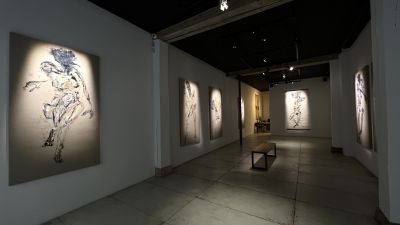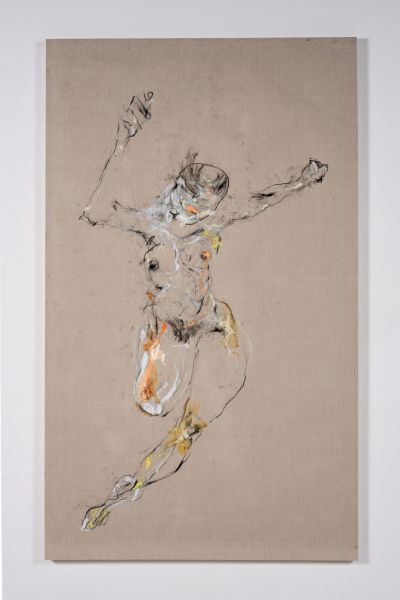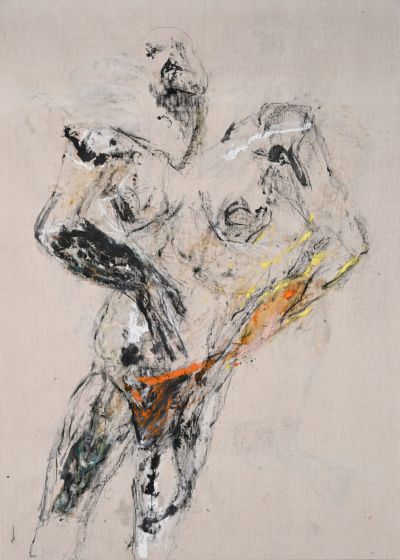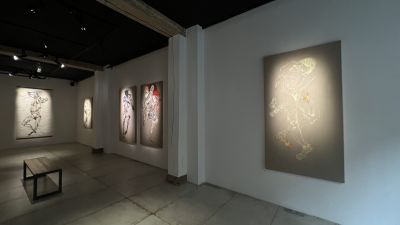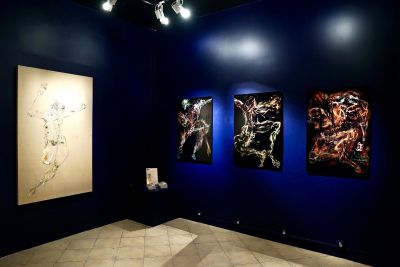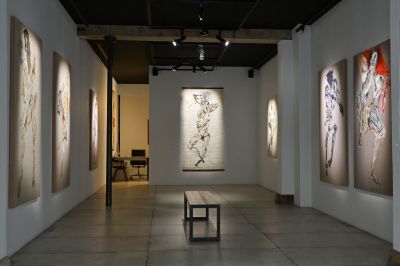Under My Skin
Placing the practice of drawing and the nude motif at the very core of his artwork, Arghaël reconnects with a long tradition of bodily representation, ranging from prehistory with the Venus of Willendorf, to the ideal of ancient perfection with Praxiteles’ statuary, to the cult of flesh, whether magnified by Renoir or unsparing as in Lucian Freud’s paintings.
As if the artist was seeking to anchor his work in a soil rich enough to bear the cadences and dances his art conjures up. Doesn't each of his drawn figures seem to be caught up in some kind of vertigo, all the more intense as each defies our usual perception of human attributes and identity ? Aren’t their faces systematically scratched in a manner similar to Artaud’s self-portraits ?
Immersing his live models in mysterious, indecipherable animal or human postures, the artist invites us to enter an ambiguous world merging man and beast, which Bacon had explored in his paintings. A world of exploding vital forces within the very hollows of our flesh. In perhaps an even cruder way, Arghaël plays with our representation of sexual organs, at times eluded, at other times, added, freeing himself –and us- from the confines of gender to question the notion of sexual identities. Through the prism of current gender studies and debates on intersexuality, his recent work with transgender models revisits the classic figure of the hermaphrodite. With its lines in perpetual motion, never fully stabilized, and its profusion of forms constantly morphing into new ones, isn’t drawing the ultimate art form to open up the body to its multiple identities ?
From that perspective, Arghaël’s artistic protocol is pure kairos captured in the drawing act itself which, through its obsessive iteration, gives his art a rare power. Far from being mere sketches for future paintings or sculptures, the artist’s drawings stand their ground, free from so-called superior art forms and claiming a territory of their own.
Far from configuring the silhouettes of his nudes, Arghaël’s raw linen canvas brings to life the invisible forces driving his models from within - under their skin.
As a graphic acupuncturist would, his hand maps out a new anatomy of who we are, using strokes of charcoal or pastels to define meridians and reveal the latent energies hidden in the many folds of human skin.
In Arghaël’s new pieces, charcoal gives way to increasingly elliptical forms, where lines are suggested yet enhanced by the fluorescence of pastels and touches of ochre chalk. The bodies spread and stretch like in André Kertész's photographs, or contort themselves in poses evoking Hans Bellmer's dismembered dolls. The hand that draws becomes one with the hand that sculpts, escaping the limits of reality to finally embrace its own, ever-lasting energy.
By Philippe Godin,
Art critic
